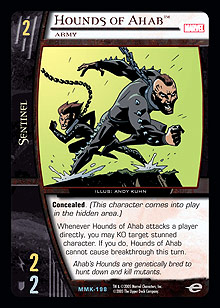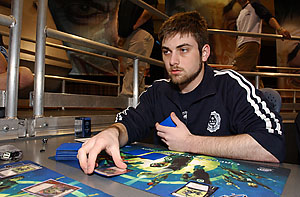
As I write this, I have just begun to travel toward Pro Circuit San Francisco. By the time you read it, I should be there, more than likely in the middle of a whirlwind of activity—endeavoring to fit the storm that is the Pro Circuit into a teacup that is just what you are looking for as part of a nice little afternoon break.
If every Pro Circuit is different, then this one is more different than most. It looks likely that the Silver Age format will be the most diverse and entertaining in recent memory; there are both new sets to consider and old ones whose stock has risen meteorically with the removal of the two Origins sets from this stop of the circuit. For the Draft portion of the event, we have the X-Men set, which, with its more aggressive focus, will stand in stark counterpoint to some of its predecessors.
By the time you read this, many of the battles will already have been won or lost. I’m not talking in terms of particular matches (though it is quite likely that there will have been some by this point . . . I would estimate approximately one winner and one loser from each), but rather of the strategic decisions made by players and teams in the run-up to the event. The decision into which possibly the most time and effort has been invested (certainly within my team, and I’m sure with many others) is that of which deck to play and what the optimal configuration of that deck might be.
While there are few matchups that are completely un-winnable (which, as a perennial supporter of the underdog, is just one of the reasons I love this game), there are definitely more or less favorable matchups for any specific build of a particular deck. Canny deck choice or tweaking of a particular archetype can be a very powerful way to set up “free wins” later on.
The idea of “free wins” is one of which I am a massive fan. They are one of the primary reasons that I have a tendency to play essentially aggressive decks with a controlling edge, such as Teen Titans. In essence, a free win is simply a game win that comes not so much as a result of a normal game of Vs. System, but rather due to some set of circumstances coming together where you can best capitalize on an unexpected opportunity.
Squadron Supreme has a nasty habit of scoring free wins by virtue of the fact that they force through disconcerting amounts of endurance loss in the early turns unless faced with some sort of early defense. Imagine a classic Big Brotherhood deck against one of the more aggressive Squadron Supreme builds. If the Brotherhood player misses an early drop or two (it is not at all uncommon for Brotherhood not to have a character before turn 3), then there is every potential for him or her never to be able to fight back after being rocked so hard in the early game.
 One of the reasons that Sentinels was so powerful was its potential to punish bad draws ruthlessly. Hounds of Ahab alone completely changed the makeup of the deck. Where before its primary win condition was to stymie opponents’ attack steps with a combination of Nimrod and Bastion (allowing for devastating swingbacks), it became a double threat with the potential to send the Hounds in when an Ounddopponent was stumbling to knock him or her over completely.
One of the reasons that Sentinels was so powerful was its potential to punish bad draws ruthlessly. Hounds of Ahab alone completely changed the makeup of the deck. Where before its primary win condition was to stymie opponents’ attack steps with a combination of Nimrod and Bastion (allowing for devastating swingbacks), it became a double threat with the potential to send the Hounds in when an Ounddopponent was stumbling to knock him or her over completely.
Sometimes, there will be effectively free wins handed to you by your opponent simply as a function of the way that the metagame is working. If you sit down with your A Child Named Valeria lock deck and your opponent plays Melissa Gold ◊ Screaming Mimi, Sonic Carapace, then you may well have stumbled into one of those serendipitous situations. Similarly, if you just happen to have a way to KO one of Checkmate’s Kings, that would fall into the realm of “happy accident.” You cannot really prepare for that sort of thing, but it’s still kind of nice when it happens.
Where things really get interesting is the relationship between tech and free wins. Is it possible to engineer them from nowhere by having a keen eye for the way that a metagame is working? I believe so. With a growing number of search effects available to a great many decks, answers to previously difficult “questions” posed by tricky decks in the format are that much easier to find, and some of them can be utterly devastating in particular matchups.
There is a fairly narrow type of clever deck technology that is best at drawing out free wins, and that is “counter-tech.” If there is a best deck in a format, then it is reasonable to assume that a fair amount of the field will be gunning for it. This is only natural and is likely a good plan for those looking to succeed in tournament play. Counter-tech is a card (or cards) that serves to cut off the effectiveness of whatever opponents are trying to do to slow down or stop the game plan of your deck.
 One of my favorite examples of this came at Pro Circuit New York. Here, Adam Bernstein was one of a majority of players running Sentinels, a deck that had a target on its forehead but just might have been powerful enough to ignore such trivialities and continue winning games. Adam’s build was fairly standard, but it did contain one inclusion that turned out to be very effective against all the decks that were posing the biggest threat to the machines’ dominance. This card was Apocalypse. That single card turned what would have been a very unfavorable matchup against Jason Hager’s New School deck into a war of attrition in which Adam was on the defensive but had a certain amount of inevitability to rely on. If the game got to turn 8, which was normally where Hager could look to edge ahead when a Sentinels build ran out of fuel, Apocalypse would be able to decimate Hager’s resource row; the one card effectively netted a free win every time it hit play.
One of my favorite examples of this came at Pro Circuit New York. Here, Adam Bernstein was one of a majority of players running Sentinels, a deck that had a target on its forehead but just might have been powerful enough to ignore such trivialities and continue winning games. Adam’s build was fairly standard, but it did contain one inclusion that turned out to be very effective against all the decks that were posing the biggest threat to the machines’ dominance. This card was Apocalypse. That single card turned what would have been a very unfavorable matchup against Jason Hager’s New School deck into a war of attrition in which Adam was on the defensive but had a certain amount of inevitability to rely on. If the game got to turn 8, which was normally where Hager could look to edge ahead when a Sentinels build ran out of fuel, Apocalypse would be able to decimate Hager’s resource row; the one card effectively netted a free win every time it hit play.
At Pro Circuit Amsterdam, a number of the better X-Statix builds were running copies of Overexposed to protect solely against Dr. Strange, who was the best hope for an aggressive Marvel Knights deck against a loner strategy that succeeded in “going long.”
With the advent of Enemy of My Enemy, there are a lot more options for every deck in the format that’s looking to cement whatever lead it has in matchups or turn matchups around with a few choice inclusions.
The good thing for those of you reading along with the Pro Circuit at home right now is that this means that players will have to get more and more creative in both their tech and in their answers to such tech.
Here’s hoping it’s the most creative Pro Circuit ever.
Have fun and be lucky.
Tim “Going Down to ’Frisco Bay” Willoughby
timwilloughby@hotmail.com